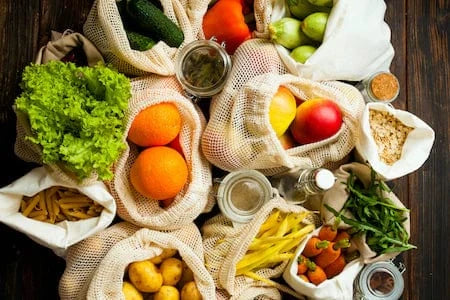
Get news, updates, & event Info delivered right to your inbox:
9 Simple and Effective Sustainable Eating Tips for a Healthier Planet
There’s a lot of advice on eating healthy, but what if you could also eat sustainably—without sacrificing the foods you love? We’ve created an easy-to-follow sustainable diet guide to help you get started.
So what, exactly is a sustainable diet? It's a diet that's vibrant, delicious, and good for both your health and the planet. It focuses on local, seasonal, and plant-based ingredients, supports sustainable farming practices, and uses fewer resources.
The food you eat has a bigger environmental impact than you might think, but by adopting a sustainable eating plan, you can make a big difference. Your diet is a personal choice, but cooking sustainable meals can be both simple and delicious.
Check Out Our 9 Sustainable Diet Tips

1. Eat More Plants
Fruits and vegetables are rich in essential nutrients that optimize our health and typically have a much lower environmental impact compared to meat, dairy, and processed foods. However, some exceptions exist, including fragile produce that is shipped thousands of miles, vegetables grown in protected conditions (like hothouse tomatoes), and resource-intensive foods like almonds and GMO soy. By eating more locally sourced, seasonal produce, you can maximize both health benefits and sustainability.

2. Eat More Variety
Our food choices are harming both our health and the planet: 75% of the global food supply comes from just 12 plant and 5 animal species. This lack of variety in our diets puts pressure on critical ecosystems and threatens global food security. To create a more nutritious, flavorful, and eco-friendly meal, try building colorful plates filled with a variety of whole foods. And don’t be afraid to try unique, locally available ingredients!

3. Reduce Your Food Waste
One-fifth of the food that is produced for human consumption is lost or wasted globally. This loss and waste generates up to 10% of global greenhouse gas emissions—nearly five times that of the aviation sector. To help reduce waste, try buying only what you’ll eat before it spoils, composting your scraps, and freezing or preserving anything you won’t use immediately. There are also many other effective ways to reduce waste beyond just your diet!

4. Eat Less Animal Products
Raising livestock for human consumption generates around 15% of total global greenhouse gas emissions—more than all transportation emissions combined. Still feel like you need animal protein to feel your best? Try limiting your consumption of meat and dairy products to just a few days a week. Whenever possible, choose more sustainable options, such as sustainably produced chicken instead of beef, to reduce your environmental impact.

5. Eat Local and Eat Seasonally
Grow your own organic vegetables or support a local, sustainable farm. Choose in-season ingredients to reduce costs, as storing food beyond its growing season can be resource-intensive. By supporting local farmers, you not only benefit your health but also contribute to your local economy.

6. Avoid Processed Foods
Aside from being bad for your health, processed foods require a lot of resources, and lose most of their nutrients during production. Even brown rice, which is considered a healthier alternative to white rice, consumes large amounts of water. To make more sustainable and nutritious choices, buy whole, unprocessed foods like buckwheat, quinoa, wild rice, unrefined barley, and wheat berries.

7. Choose Sustainably Sourced Seafood
Seafood can be a healthy addition to your diet, but high demand and poor management have resulted in overfishing of popular species like North Sea cod and wild Atlantic salmon. To make more sustainable choices, explore alternatives such as barramundi, wild-caught sardines, or sustainably farmed shellfish. These options are not only delicious but also better for the environment.

8. Give Plant Proteins a Chance
Plant-based proteins, such as beans, pulses, and certain grains, are far less resource-intensive than animal proteins like beef and chicken. They are also heart-healthy and easier to digest. For a delicious, sustainable alternative, try swapping lentils for beef in dishes like tacos or shepherd’s pie—it's a flavorful and filling option that you might just love!

9. Buy in Bulk
Proper food packaging, especially of meat and seafood, is critical for food safety. But when it is practical, opt for bulk items instead of individually packaged products, bring reusable shopping and bulk bags to the store, and choose products with sustainable packaging materials to help minimize waste
We hope this list has inspired you to make your diet more sustainable! Ready to take your eco-efforts further? Support reforestation today to help create a greener, healthier planet for future generations!
Get news, updates, & event Info delivered right to your inbox:
Related Posts
9 Sustainable New Years Resolutions
18/12/2025 by Meaghan Weeden
Inspirational Quotes About Trees
16/12/2025 by Meaghan Weeden
The 9 Oldest, Tallest, and Biggest Trees in the World
11/12/2025 by One Tree Planted
Popular On One Tree Planted
Inspirational Quotes About Trees
16/12/2025 by Meaghan Weeden
The 9 Oldest, Tallest, and Biggest Trees in the World
11/12/2025 by One Tree Planted
What Causes Deforestation?
10/07/2025 by Meaghan Weeden
Fundraising Disclosures

Be Part of the
Restoration Movement
The Grove is more than just a monthly giving program: it's a vibrant community of individuals who are dedicated to reforestation and environmental restoration on a global scale.
As a member of The Grove, you affirm your commitment to restoring forests, nurturing biodiversity, and fostering positive global change.



